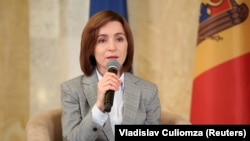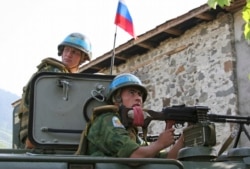In a November 15 runoff election, voters in Moldova chose former Prime Minister Maia Sandu as the country’s first female president. Sandu is seen as a Western-oriented leader, especially when compared to her opponent, incumbent President Igor Dodon, who enjoyed Russian President Vladimir Putin’s backing.
On December 1, Sandu called for Russian military forces to be removed from Transnistria, the breakaway territory bordering Ukraine to the east that is internationally recognized as part of Moldova.
“We are an independent country that does not want foreign troops to stay on its territory,” she said at a news conference in Chisinau, the Moldovan capital.
The reaction of Russian officials and media was uniformly negative.
Russia’s TASS state news agency quoted Foreign Ministry Sergey Lavrov as telling reporters on December 1: "It’s hard to say what Ms. Sandu meant when she pointed to the need to withdraw Russian peacekeepers, but it will hardly help resolve the issue, and we will hardly be able to accept this kind of irresponsible demand.”
Lavrov added: "There is another group of Russian troops that guard ammunition depots in [the Transnistrian town of] Cobasna. The depots are in poor condition and serious incidents can happen if there is no one left to monitor them."
Lavrov’s statements are misleading.
Sandu’s position not only called for the withdrawal of Russian troops, but proposed replacing them with a civilian monitoring mission under the aegis of the Organization for Security and Cooperation in Europe (OSCE). Therefore, she did not advocate leaving the arms depots in question unmonitored. The BBC reported that Sandu vowed to continue working with Russia on arms control.
Sandu ‘s call for Russia’s “peacekeepers” to be withdrawn from Transnistria is not the first. In 2018, the United Nations approved a resolution calling for the unconditional withdrawal of the Russian troops from the breakaway Molodovan region, noting that the Operational Group of Russian Forces there is not in fact part of a Joint Control Commission established in 1992 as part of a ceasefire agreement.
The resolution also refers to the agreement between Russia and the OSCE reached at the latter’s 1999 Istanbul summit, which called for a full withdrawal of Russian forces by 2002.
The Operational Group of Russian Forces that Sandu wants out of her country are not a “peacekeeping” force in the traditional sense, like those associated with the United Nations. The U.N. resolution urging the withdrawal of Operational Group of Russian Forces notes that these Russian forces have taken part in joint exercises with the armed militias of the unrecognized Russian-backed government in Transnistria. The Russian troops are seen as the descendants of the original Soviet formations that helped set up the pseudo-state in 1992.
Russian “peacekeepers” have played a role in other post-Soviet conflicts as well.
In the five-day Russo-Georgian war of August 2008, part of the pretext for Russian intervention against Georgia was that Russian peacekeepers stationed in the breakaway Georgian republic of South Ossetia had come under Georgian attack. After the war, the Russian military occupied the breakaway Georgian republics of South Ossetia and Abkhazia, violating international agreements.
The Russian “peacekeepers” in Transnistria and other Russia-backed breakaway republics are seen not as neutral but as active supporters of those republics’ armed forces, essentially propping them up and perpetuating frozen conflicts.
During the 1992 Transnistrian War that led to today’s frozen conflict in Moldova, elements of the Soviet 14th Army stationed in newly-independent Moldova, which then Russian President Boris Yeltsin put under Russian military jurisdiction, backed local ethnic Russian separatists who attempted to secede from Moldova. The 14th Army’s support of the separatists was critical in thwarting Moldovan government forces’ attempts to establish control over Transnistria. Chisinau was forced to agree to a ceasefire that effectively froze the conflict.
It is also open to question of how effective the Russian force in Transnistria has been in fulfilling its putative purpose of arms control and securing the Cobasna weapons depot. It is one of the largest such depots in Eastern Europe containing weapons largely left over from the Soviet era.
For most of its existence, Transnistria has been an infamous hub for trafficking of all kinds, including arms trafficking. Russia and the Russian military in Transnistria has reportedly aided and abetted such illegal activity.
In the early 2000s, British intelligence agents traced arms trafficked via Transnistria to the infamous arms dealer Viktor Bout, a Russian citizen who was convicted in the U.S. on federal charges in 2011. More recently, Transnistria’s reputation for illicit trafficking has declined, but not necessarily due to the efforts of the Russian “peacekeepers.”
After Russia annexed Crimea in 2014 and the war in Ukraine’s eastern Donbas region started, Ukraine began increasing scrutiny along its border with Transnistria. Previously, Ukraine had been a major source and destination for contraband trafficked via Transnistria. Thus, smuggling may have decreased not as a result the presence of Russian troops, as Lavrov suggests, but thanks to the Ukrainian crackdown.
On December 3, NATO Secretary-General Jens Stoltenberg voiced support for Moldova’s new president Sandu.
“We see how Russia has deployed troops that violate international law, how Russia has illegally annexed Crimea, how it continues to destabilize eastern Ukraine, how there are Russian troops in regions of Georgia, and also how there are troops in Moldova, in Transnistria,” Stoltenberg said.






